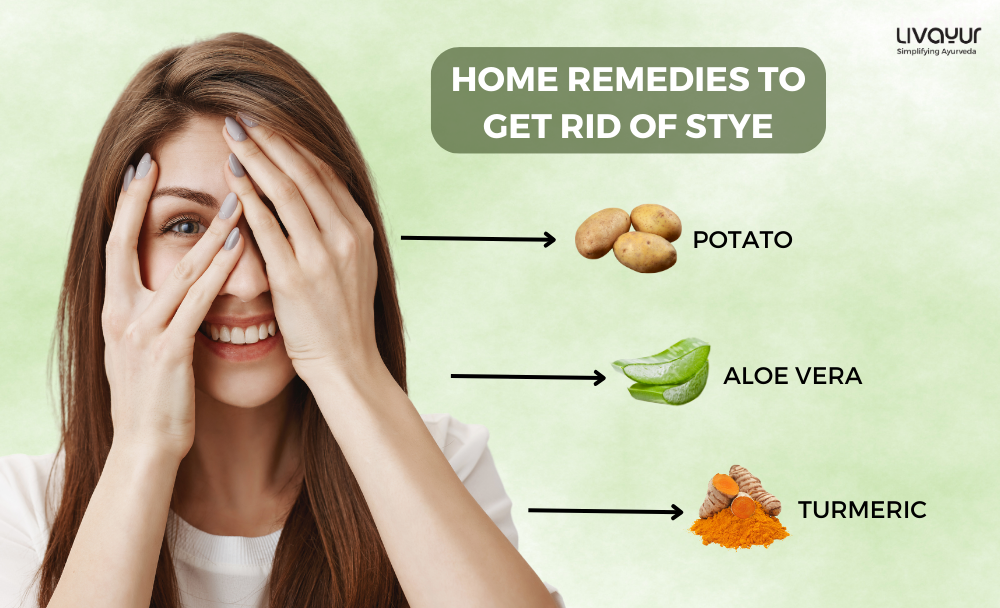This article is reviewed by an expert

A stye is a bacterial infection of an oil gland or a hair follicle in the eyelid. This results in a red tender bump at the edge of the eyelid that may look like a boil or a pimple. Styes are often filled with pus and inflammatory cells that are produced when the clogged gland or follicle becomes infected. A stye can be on the outside (external) or inside (internal) of the eyelid. External styes are more common and usually start in an eyelash follicle, while internal styes start in an oil gland within the eyelid tissue. The problem usually occurs due to infection with Staphylococcus aureus or Staphylococcus epidermidis that enters the eye from touching or rubbing the area with unclean hands. Fortunately, there are natural stye treatments that you can use at home.
How Stye is Caused
A stye, also known as a hordeolum, is a red pimple-like protrusion that develops on the outside corner of the eyelid.
Eyelids have lots of tiny oil glands around them, particularly around your lashes. These tiny openings can get clogged or blocked by oil buildup, dirt, or dead skin. Bacteria within a blocked gland can proliferate and result in the development of a stye.
Symptoms of Stye
- Soreness and itching
- A crust that builds around the eyelid
- Pain and swelling
- Increased tear production
Home Remedies For Styes
1. Apply Warm Compresses
Apply warm compresses to the affected eye for 5 to 10 minutes, several times a day. The warmth helps increase blood circulation, reduces inflammation, and aids in the drainage of the stye. Warm compresses are widely recommended by ophthalmologists as an effective stye treatment for quick relief [1].
2. Apply Tea Tree Oil
Stye home remedy tea tree oil is the ideal quick solution. Dilute tea tree oil with a carrier oil, such as coconut oil, and apply it to the stye using a clean cotton swab. Tea tree oil possesses antimicrobial properties that can help combat the bacteria causing the stye. Several studies have demonstrated the antibacterial effects of tea tree oil against common stye-causing bacteria, making it a popular stye home treatment [2].
3. Apply Manuka Honey for stye
This is perhaps the simplest and safest eye stye treatment. Simply apply a small amount of medical-grade manuka honey to the stye and leave it on for 15 minutes before rinsing off with warm water. Honey for stye exhibits antimicrobial and anti-inflammatory properties, with research showing that it has potent antibacterial activity against bacteria commonly associated with styes [3].
4. Apply Saline Solution
Mix a teaspoon of salt in a cup of warm water to create a saline solution. Use a clean cotton ball or cotton swab to apply the solution to the stye. Saline solution helps cleanse the affected area and reduce inflammation. It is a commonly recommended home remedy for styes and has been suggested by healthcare professionals as the first line of external or internal stye treatment [4].
5. Cleanse with Medicated Soap And Water
Cleansing with a gentle soap and water helps to prevent further infection and irritation of the eye area. Avoid harsh, synthetic chemicals and use hypoallergenic and non-irritating ingredients. Gently wash your eyelid with soap and water twice a day and pat it dry with a clean towel.
6. Apply Aloe Vera
This is a natural remedy that has anti-inflammatory and antibacterial properties that can help soothe and heal your stye [5]. Apply aloe gel to the affected area and leave it for 20 minutes. Rinse it off with warm water. Repeat this three times daily until the stye is gone.
7. Apply Turmeric Paste
This is a spice that has anti-inflammatory and antibacterial properties that can help reduce swelling and infection of the stye [6]. Add one teaspoon of turmeric powder to two cups of water and boil it until it reduces by half. Strain the liquid and let it cool down. Use this as an eye rinse twice daily for a few days. You can also make a paste of turmeric powder and water and apply it to the stye for 15 minutes. Rinse it off with warm water. Repeat this twice daily for a few days.
8. Rinse with Coriander Seeds water
These are seeds that have anti-inflammatory properties that can help relieve the pain, swelling, and redness of the stye [7]. Add one teaspoon of coriander seeds to a cup of water and boil it for a few minutes. Turn off the heat and let the water cool down. Strain the liquid and use it as an internal stye treatment by rinsing the affected eye with the solution. Do this at least two or three times daily until the stye heals.
9. Apply Green Tea
This is a tea that has anti-inflammatory and antioxidant properties that can help reduce swelling and infection of the stye [8]. Soak a green tea bag in warm water for a few minutes. Squeeze out the excess water and place the tea bag over your eye for 10 minutes. Repeat this three or four times a day until the stye is gone.
10. Place Guava Leaves
These are leaves that have anti-inflammatory properties that can help reduce pain and swelling of the stye [9]. Wash some guava leaves and warm them in the microwave for a few seconds. Place them on a warm cloth and wrap it around your eye for 10 minutes. Repeat this twice daily until the stye heals.
11. Apply Castor Oil
Although best known for its digestive benefits, castor oil exhibits anti-inflammatory properties that can help reduce the swelling and pain of a stye. Wash your eye with warm water and pat it dry with a clean towel . Dip a cotton swab in castor oil and apply it to the stye. Leave it on overnight or for as long as possible. Repeat this once or twice daily until the stye is gone.
12. Place Grated Potato
This is a vegetable that has astringent properties that can help shrink the stye and reduce inflammation. Peel and grate a potato and wrap it in a cheesecloth. Place it over your eye for 15 minutes. Repeat this three times daily until the stye heals.
How to Prevent Stye?
You run a higher chance of developing another stye after getting one. Additionally, styes might develop inside your eyelid. The numerous germs in the pus may lead to the formation of another stye in your eye, the other eye, or even in a different individual.
To Prevent Stye:
- Before touching your eyes, give your hands a quick wash with soap and water.
- Using a Q-tip soaked in warm water and a small amount of soap or shampoo, clean the eyelids.
- Every night before going to bed, remove your eye makeup.
- Towels should not be shared with people who have styes due to the possibility of bacteria lingering on them. Styes do not transfer bacterial infections through casual contact, but the abundance of bacteria on a towel can.
When to Visit a Doctor?
Speak with your physician if you:
- have larger, more painful interior swelling that doesn’t go away with at-home treatment and impairs vision
- experience recurring seizures as well
They could be the outcome of an underlying illness such as cellulitis, blepharitis, or conjunctivitis.
Conclusion
Although these home stye treatments are effective, you should follow other precautions to ensure healing. Remember to avoid wearing makeup, contact lenses, or sharing towels until your stye heals completely. Also, wash your hands frequently and avoid touching your eyes to prevent the spread of the infection. If your stye does not improve within a week or if you have severe symptoms such as fever, vision problems, or eyelid drooping, you should see a doctor for medical treatment.
FAQs
1. How serious is a stye?
A stye is not regarded as a serious health problem and is usually non-threatening, causing only irritation, but no damage to the eyes or eyelids. However, if the problem persists and causes other symptoms you should seek medical care as there could be some complications.
2. Can you remove a stye at home?
You should not attempt to remove or drain a stye at home as this can result in further infection or damage to the area. If required, a doctor can get rid of a stye by making an incision and draining the fluid. This is a minor procedure involving a numbing agent but requires no stitches.
3. What happens if you have a stye for a long time?
Although styes usually resolve without treatment in a few days, a severe stye that persists can cause a hard small lump or nodule to form in the eyelid, affecting vision. This would then require medical treatment and removal.
Disclaimer:
The information provided here is for general information and is not meant to substitute any medical advice. Please consult your doctor for appropriate medical consultation.
References:
- https://onlinelibrary.wiley.com/doi/abs/10.1111/j.1746-1561.1991.tb03246.x?sid=nlm%3Apubmed
- https://www.ncbi.nlm.nih.gov/pmc/articles/PMC5848340/
- https://pubmed.ncbi.nlm.nih.gov/27429228/
- https://www.ncbi.nlm.nih.gov/pmc/articles/PMC5370090/
- https://www.ncbi.nlm.nih.gov/pmc/articles/PMC2763764/
- https://www.ncbi.nlm.nih.gov/pmc/articles/PMC5306202/
- https://www.ncbi.nlm.nih.gov/pmc/articles/PMC8747064/
- https://www.ncbi.nlm.nih.gov/pmc/articles/PMC5376801/
- https://www.ncbi.nlm.nih.gov/pmc/articles/PMC5412476/
- https://pubmed.ncbi.nlm.nih.gov/33037703/




















